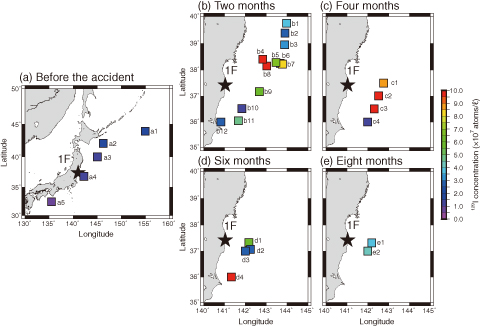
Fig.1-3 Oceanographic stations and concentration of 129I measured in this study
If radioactive iodine is accidentally released into the environment from a nuclear facility, it is necessary to survey the migration of this iodine through the environment. We have developed a technique for measuring iodine-129 (129I) in environmental samples using accelerator mass spectrometry (AMS), and we have investigated the background level of 129I to prepare for unexpected accidents. In March 2011, the accident at the TEPCO’s Fukushima Daiichi NPS (1F) caused radioactive iodine to be released into the ocean. We have studied the migration of the accident-derived 129I in the sea area around Fukushima using our developed method and background data.
Before the accident, seawater samples had been collected at five stations in the western North Pacific Ocean (Fig.1-3(a)). After the accident, samples were collected at 12 stations after two months (Fig.1-3(b)), four stations after four months (Fig.1-3(c)) and six months (Fig.1-3(d)), and two stations after eight months (Fig.1-3(e)). Concentrations of 129I in the seawater samples were measured using AMS.
The concentrations of 129I in surface seawater around the western North Pacific Ocean before the accident were (0.94−1.83) ×107 atoms/ℓ. After the accident, the concentrations of 129I were (1.08−89.8) ×107 atoms/ℓ. The maximum value was observed at station c3 four months after the accident, and the minimum was observed at stations b10 and c4 two and four months after the accident, respectively. The maximum was 80 times higher than the background value before the accident. The minimum concentrations were at the same level as the background value before the accident. A wide range of 129I concentrations in surface seawater were observed around the 1F site for several months following the accident. It is believed that this result was induced by the complex flow field with the Oyashio and Kuroshio currents flowing into this region, and the corresponding mesoscale eddies. Since the concentration of 129I in surface seawater after eight months from the accident decreased to the background level, it has been shown that the concentration of accident-derived 129I has been reduced by time.
The findings of this study can be applied to simulation models that predict the distribution of radionuclides in seawater.
<Previous: 1 Research and Development Relating to the Accident at the TEPCO’s Fukushima Daiichi NPS | Next: 1-2 >